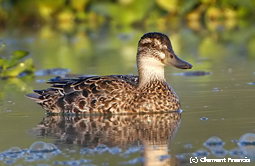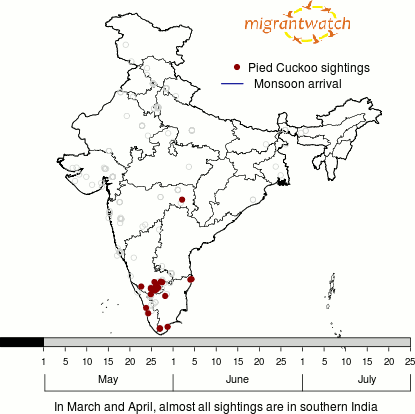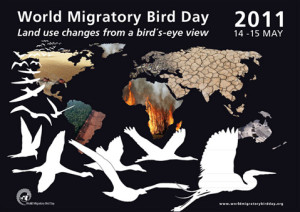Many birders who keenly monitor wetlands across the country have had a somewhat disquieting year. It seems that several migratory birds across the country have been giving some of their usual haunts a miss. Newspaper articles1-6 over the past months have reported lower number of birds or few species of birds from wetlands across the country. Even some of the most widespread and common migrants like the Garganey have not been seen at a number of locations across their recorded distribution in India.
Reports from the latest Asian Waterbird Census suggest that a number of regular migrants at Delhi’s Okhla Bird Sanctuary, like the Black-tailed Godwit and Garganey (photo), did not turn up this year, while several other species like Gadwall and Bar-headed Goose arrived in much smaller numbers1,2. Similar patterns have been reported from the Keoladeo Ghana National Park in Bharatpur3 and sites across Maharashtra4 and Karnataka5,6.
suggest that a number of regular migrants at Delhi’s Okhla Bird Sanctuary, like the Black-tailed Godwit and Garganey (photo), did not turn up this year, while several other species like Gadwall and Bar-headed Goose arrived in much smaller numbers1,2. Similar patterns have been reported from the Keoladeo Ghana National Park in Bharatpur3 and sites across Maharashtra4 and Karnataka5,6.
The media reports, mostly informed by local expertise, have suggested that apart from the usual suspect (habitat loss), unseasonal rains just before the onset of winter are a major reason for the altered patterns. The most severely affected habitats appear to be natural and man-made wetlands that lie downstream of large dams in rain-affected areas. The argument is that water released from the dams submerged islands presumably making conditions unfavourable for a number of species such as the Garganey that forage in shallow water.
MigrantWatch Data
A glance at the MigrantWatch data also seems to suggest that some of the species have been reported from fewer locations this year as compared to last year. (Links lead to MigrantWatch data on the species.)
The Garganey (Anas querquedula) was not reported from Hyderabad, Pune and Nagpur this season (2010-2011) but it was reported from these locations last season (2009-2010). The Mallard (Anas platyrhynchos) was reported from Jamnagar in Gujarat and Udaipur in Rajasthan last season (2009-2010) but not this season. The Common Pochard (Aythya farina) during 2010-11 has been reported less than half as often and from far fewer locations than during the 2009-10 or 2008-09 seasons. The Tufted Duck (Aythya fuligula) was only reported from Uttarakhand, Goa and two locations in Gujarat this season; last season it was also reported from locations in Uttar Pradesh, Delhi, Rajasthan, Himachal Pradesh and Madhya Pradesh. The Black-tailed Godwit also was not reported from locations in Goa, Kerala and Karnataka this season.
We should caution that these findings (about MigrantWatch sightngs) should not be taken as definitive. Since the total number of sightings reported to MigrantWatch in the 2010-2011 season is lower than in the previous season (1,887 versus 2,745), it is possible that the absence of species from particular sites or States may simply reflect the lower reporting rate. Note also that MigrantWatch does not have the goal of assessing year-to-year changes in species distribution or abundance — for that, the Asian Waterbird Census is the appropriate source of information.
Still, sightings reported to MigrantWatch contribute to an overall picture of what is happening to our migrant species. So please do upload your sightings for this season to MigrantWatch so that the combined information becomes more and more valuable.
While it is not new that climate (including rainfall) can affect the distribution of waterbirds, much remains unknown. For instance, where do the displaced migrants go? Do they merely redistribute themselves locally, moving to other wetlands created by the rains? Or, do the changes in rainfall patterns bring about much larger-scale changes in bird migrations? If you have information or an opinion on these questions, please do add a comment to this post.
Newspaper Articles –
1. Some sightings, several misses at Asian waterbird census; Hindustan Times, New Delhi, January 24, 2011
2. Migratory bird count falls sharply in Delhi; The Hindu, New Delhi, March 08, 2010
3. Jairam blasts Gehlot over dry Bharatpur sanctuary; The Pioneer, New Delhi, November 26, 2010
4. Migratory birds fail to weather rain, fall in numbers; The Times of India, Pune, December 11, 2010
5. Migratory bird numbers go south; The Hindu, Mysore, December 22, 2010
6. Urban migration? Not anymore for Bangalore birds; Express Buzz, Bangalore, Feb 16, 2011
 To illustrate the general pattern of migration of this species, we have put together this animated map, which shows the progression of Pied Cuckoo migration across the country in advance of the monsoon.
To illustrate the general pattern of migration of this species, we have put together this animated map, which shows the progression of Pied Cuckoo migration across the country in advance of the monsoon.

 suggest that a number of regular migrants at Delhi’s Okhla Bird Sanctuary, like the Black-tailed Godwit and Garganey (photo), did not turn up this year, while several other species like Gadwall and Bar-headed Goose arrived in much smaller numbers1,2. Similar patterns have been reported from the Keoladeo Ghana National Park in Bharatpur3 and sites across Maharashtra4 and Karnataka5,6.
suggest that a number of regular migrants at Delhi’s Okhla Bird Sanctuary, like the Black-tailed Godwit and Garganey (photo), did not turn up this year, while several other species like Gadwall and Bar-headed Goose arrived in much smaller numbers1,2. Similar patterns have been reported from the Keoladeo Ghana National Park in Bharatpur3 and sites across Maharashtra4 and Karnataka5,6. Even if you’re not on Twitter, you can follow the exciting adventures of Dinara. This female Sociable Lapwing (Vanellus gregarius) is one among nine birds that have been fitted with state-of-the-art satellite tags by scientists at the Sociable Lapwing Project, a collaborative effort by BirdLife International, Swarovski and The Royal Society for the Protection of Birds. Thanks to ‘The Amazing Journey’ – the popular face of this project – internet users can follow, real time, the migratory movements of these birds. The tags have revealed that these nine Sociable Lapwings, which breed in Kazakhstan, overwinter in places as far apart as Saudi Arabia and India. Dinara herself was at the Little Rann of Kutch over the new year. Learn more about the life of one of the planet’s rarest birds at
Even if you’re not on Twitter, you can follow the exciting adventures of Dinara. This female Sociable Lapwing (Vanellus gregarius) is one among nine birds that have been fitted with state-of-the-art satellite tags by scientists at the Sociable Lapwing Project, a collaborative effort by BirdLife International, Swarovski and The Royal Society for the Protection of Birds. Thanks to ‘The Amazing Journey’ – the popular face of this project – internet users can follow, real time, the migratory movements of these birds. The tags have revealed that these nine Sociable Lapwings, which breed in Kazakhstan, overwinter in places as far apart as Saudi Arabia and India. Dinara herself was at the Little Rann of Kutch over the new year. Learn more about the life of one of the planet’s rarest birds at